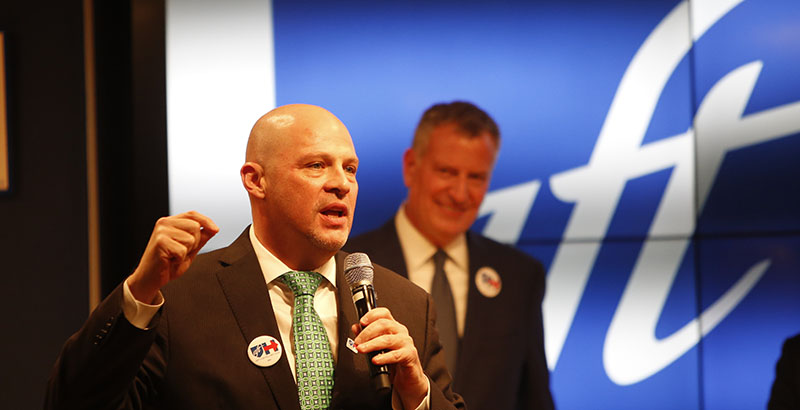Analysis: Schools and Their Unions Have Responded Admirably to the Coronavirus Crisis. What Happens to Labor Relations Now?

Mike Antonucci’s Union Report appears most Wednesdays; see the full archive.
Never before in history have America’s schools been forced to abruptly shut down and then immediately transition to an entirely new method of instruction. For the most part, school systems have handled this enormous task with common sense and grace. This includes teachers, support employees and their unions.
Everyone agrees that this is far from an ideal learning atmosphere. Reporters routinely cover the lack of computers and internet access, particularly in low-income neighborhoods. But even considering those limitations, “attendance” for online school is poor, and in some cases it is not being addressed at all.
The type of instruction being offered is all over the map. Some districts insist on carrying the regular curriculum forward. Others opt for review. Some demand too much homework, and others have few expectations for students.
Stuck in the middle are teachers, who have to navigate the various demands of their districts against the realities of distance learning. The situation resembles that of soldiers in the trenches trying to reconcile the orders they receive from headquarters with the chaotic battlefield they see with their own eyes.
It is inevitable that many will turn to their unions for support. Almost everywhere, school employee unions have recognized the unique situation we are in and chosen to put aside differences and pull together with their district. To this point, their quarrels are with politicians rather than with administrators and principals.
Unions are not known for being nimble and flexible. So it is all the more remarkable that they are mostly resisting the impulse to resist. There have been a lot of changes in a very short period of time, and that’s disconcerting for organizations that rely on establishing procedures to account for every eventuality.
School employee unions are grappling with this new reality on three levels: the immediate situation; the return to in-person schooling; and the fate of their normal agenda.
With collective bargaining agreements that run hundreds of pages essentially thrown out the window, unions return to their most fundamental mission: the protection of members. They are focused on seeing to it that teachers continue to be paid their full salaries and that few or no layoffs occur.
This is a relatively easy task when it comes to teachers, but not so much for support employees. With school buildings closed, it is harder to justify an army of custodians, bus drivers, maintenance workers and teachers’ aides. Those workers will suffer first, and we are already seeing that happening in some places.
The other short-term priority is managing expectations. We are seeing many unions negotiating limits on the number of hours teachers are required to be online. They want to cancel standardized testing and teacher evaluations. How to grade students is also an issue. The purpose of all this is the reasonable request that teachers and students not be harshly judged on their performance under very difficult circumstances.
We are nearing the end of the school year, and soon all our thoughts will turn to reopening schools. This is where we are likely to see a lot of the collaboration and good fellowship dissipate. Lost in the debate over the relative risk for students to attend school was the danger for teachers and other school employees who were exposed to possibly asymptomatic but contagious students each day. The United Federation of Teachers in New York City was especially critical of the delay in closing schools, even to the point of hinting that it will file grievances or legal complaints about it. Before reopening, unions will want to ensure that their members are safe and secure in their classrooms.
Then there are the questions about what level of social distancing will be necessary and how that will be managed. Some have suggested staggering the school day or maintaining some level of distance learning. How will that affect staffing? Custodial work? Food service?
Once the height of the crisis is over, unions won’t let school districts wing it anymore. They will demand answers to these questions, or their members won’t return to work.
Finally, the school employee unions still have to consider what effect the epidemic had, and will continue to have, on their pre-virus plans. Some unions are still involved in regular collective bargaining, not just negotiating special memorandums of understanding to cover COVID-19 issues.
With a booming economy, unions expected to score big raises and increased hiring. Now, they have to deal with the likelihood of pay freezes, furloughs and reductions in force. How will political action committee fundraising and get-out-the-vote efforts be impacted? In California, unions placed a business property tax initiative on the November 2020 ballot. Will there be much sentiment to boost taxes in a recession, and will enough businesses survive the shutdowns to make such a tax worthwhile?
Even something as fundamental as union membership levels are now in question. Fewer jobs means fewer members, and there is no way to predict what effect the virus and its aftermath will have on individual decisions to join or remain in a union.
Unions, like the rest of us, will have to determine which changes in human interaction caused by the virus will be permanent and which will be transitory. Their ability to adapt will be put to the test. It’s a new world, and the old rules may no longer apply.
Get stories like these delivered straight to your inbox. Sign up for The 74 Newsletter

;)